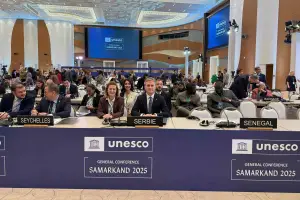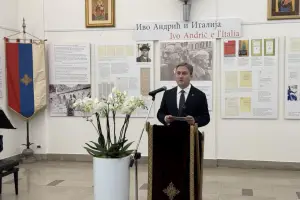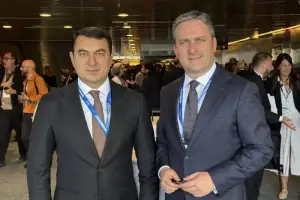- Serbia
Get to know Serbia
- Citizens
Culture and science
Health services
Pension and disability insurance
- Business
Employment
Economy
- Media
- Government
- Contact
Keep in touch
Contact form
Back
Keepin touch
Whether you have a question, comment, suggestion or any problem in the purview of the government, send us your message and we will try to respond as soon as possible. If your problem is not in our purview, we will forward your message to the relevant institution.
Q:
A:
Rehabilitation project for mining town Senjski Rudnik begins
Despotovac,
13 June 2009
Minister of Culture Nebojsa Bradic and Head of the European Commission Delegation to Serbia Josep Lloveras today marked the beginning of a rehabilitation project in the mining town of Senjski Rudnik, which was the birthplace of Serbia’s industrialization.
The project for the transformation of Senjski Rudnik into an eco-museum and regional cultural centre received support from the EU through the Regional Programme for the Cultural and Natural Heritage of South East Europe and a joint Council of Europe and European Commission plan for the rehabilitation of the architectural and archaeological heritage of the region.
This is the first project in Serbia concerning cultural development to be financed by the EU to the amount of €1.5 million.
Although an official approval is expected to come into force in autumn, Bradic stressed that by unveiling a board marking the Regional Programme for the Cultural and Natural Heritage of South East Europe on a museum building, the process of transforming Senjski Rudnik into an eco-museum started today.
The Minister pointed to the importance of the project for Serbia, particularly for citizens of this area.
He voiced his belief that cultural decentralisation and regionalisation will encourage the development of local communities and bring hope to young people living here.
Lloveras said that this project is better than 26 other projects from South Eastern Europe that also applied for European Commission financial assistance.
He voiced his belief that the European Commission will do its best to reconstruct this beautiful area and bring it back to Serbia’s tourism map, adding that he is surprised with the fact that the mining town of Senjski Rudnik is not included in Serbia’s guide books.
EU integration implies not only the drafting of laws, but also the preservation and development of cultural heritage, stressed Lloveras.
Zlatko Dragosavljevic, the Director of the public company for underground coal exploitation Senjski Rudnik, recalled that this mine has been providing brown coal for entire Serbia for the past 156 years, thus contributing a lot to the development of railway traffic, energetics and the electromechanical industry.
Senjski Rudnik currently employs 230 people, 180 of which are miners and produces around 45 thousand tones of coal per year.
This is the first project in Serbia concerning cultural development to be financed by the EU to the amount of €1.5 million.
Although an official approval is expected to come into force in autumn, Bradic stressed that by unveiling a board marking the Regional Programme for the Cultural and Natural Heritage of South East Europe on a museum building, the process of transforming Senjski Rudnik into an eco-museum started today.
The Minister pointed to the importance of the project for Serbia, particularly for citizens of this area.
He voiced his belief that cultural decentralisation and regionalisation will encourage the development of local communities and bring hope to young people living here.
Lloveras said that this project is better than 26 other projects from South Eastern Europe that also applied for European Commission financial assistance.
He voiced his belief that the European Commission will do its best to reconstruct this beautiful area and bring it back to Serbia’s tourism map, adding that he is surprised with the fact that the mining town of Senjski Rudnik is not included in Serbia’s guide books.
EU integration implies not only the drafting of laws, but also the preservation and development of cultural heritage, stressed Lloveras.
Zlatko Dragosavljevic, the Director of the public company for underground coal exploitation Senjski Rudnik, recalled that this mine has been providing brown coal for entire Serbia for the past 156 years, thus contributing a lot to the development of railway traffic, energetics and the electromechanical industry.
Senjski Rudnik currently employs 230 people, 180 of which are miners and produces around 45 thousand tones of coal per year.
-
 Belgrade, 10 November 2025
Belgrade, 10 November 2025Initiative to ban photo exhibition “Serbian Woman” attack on historic memory
-
 Belgrade, 8 November 2025
Belgrade, 8 November 2025Croatia obliged to respond adequately to emergence of hatred, extremism against Serbs
-
 Belgrade/Cairo, 3 November 2025
Belgrade/Cairo, 3 November 2025Culture as foundation for enhancing overall relations between Serbia, Egypt
-
 Belgrade/Samarkand, 31 October 2025
Belgrade/Samarkand, 31 October 2025Serbia’s continued commitment to preservation of cultural heritage
-
 Požarevac, 24 October 2025
Požarevac, 24 October 2025Strengthening cooperation with Cyprus in field of cultural heritage protection
-
 Belgrade/Trieste, 18 October 2025
Belgrade/Trieste, 18 October 2025Exhibition on Ivo Andrić in Trieste new bridge of cultural cooperation with Italy
-
 Belgrade, 7 October 2025
Belgrade, 7 October 2025Condemnation of marking Serbian cultural heritage as Albanian
-
 Belgrade/Osaka, 5 October 2025
Belgrade/Osaka, 5 October 2025Virtual promotion of Serbian tradition, culture in Osaka
-
 Belgrade/Barcelona, 1 October 2025
Belgrade/Barcelona, 1 October 2025Cultural heritage as foundation of preserving national identity
-
 Belgrade/Barcelona, 29 September 2025
Belgrade/Barcelona, 29 September 2025Cultural cooperation between Serbia, Azerbaijan to further strengthen overall relations
